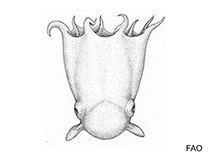Opisthoteuthis hardyi Villanueva, Collins, Sanchez & Voss, 2002
| Native range | All suitable habitat | Point map | Year 2050 |

|
| This map was computer-generated and has not yet been reviewed. |
| Opisthoteuthis hardyi AquaMaps Data sources: GBIF OBIS |
Google image | No image available for this species;
drawing shows typical species in Opisthoteuthidae.
Classification / Names Common names | Synonyms | CoL | ITIS | WoRMS
Cephalopoda | Octopoda | Opisthoteuthidae
Environment: milieu / climate zone / depth range / distribution range Ecology
Pelagic; depth range 630 - 1390 m (Ref. 96968). Polar
Distribution Countries | FAO areas | Ecosystems | Occurrences | Introductions
Antarctic Atlantic: South Georgia.
Length at first maturity / Size / Weight / Age
Maturity: Lm ? range ? - ? cm Max length : 28.5 cm TL male/unsexed; (Ref. 96968)
Life cycle and mating behavior Maturity | Reproduction | Spawning | Eggs | Fecundity | Larvae
Main reference
References | Coordinator | Collaborators
Villanueva, R., M.A. Collins, P. Sanchez and N.A. Voss 2002 Systematics, distribution and biology of the cirrate octopods of the genus Opisthoteuthis (Mollusca, Cephalopoda) in the Atlantic Ocean, with description of two new species. Bull. Mar. Sci. 71(2):933-985. (Ref. 84341)
IUCN Red List Status
(Ref. 130435: Version 2025-1)
CITES status (Ref. 108899)
CMS (Ref. 116361)
Threat to humans
Human uses
| FishSource |
Tools
More information
Diet composition
Food consumption
Predators
Max. ages / sizes
Length-weight rel.
Length-length rel.
Length-frequencies
Mass conversion
Abundance
Internet sources
BHL | BOLD Systems | CISTI | DiscoverLife | FAO(Publication : search) | Fishipedia | GenBank (genome, nucleotide) | GloBI | Gomexsi | Google Books | Google Scholar | Google | PubMed | Tree of Life | Wikipedia (Go, Search) | Zoological Record



